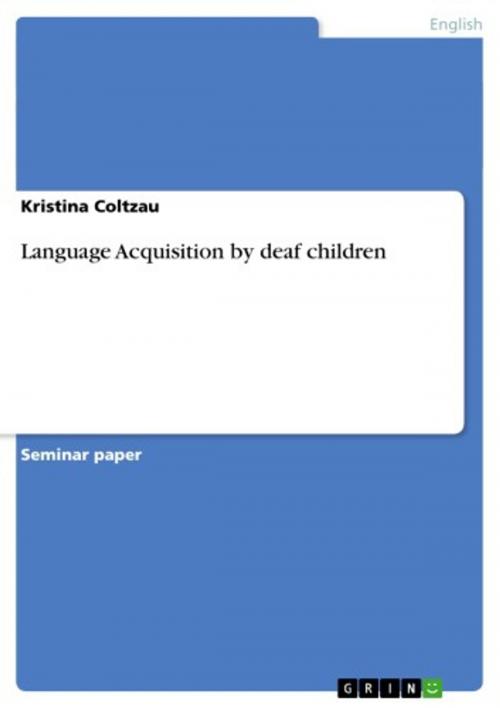| Author: | Kristina Coltzau | ISBN: | 9783656042181 |
| Publisher: | GRIN Verlag | Publication: | October 31, 2011 |
| Imprint: | GRIN Verlag | Language: | English |
| Author: | Kristina Coltzau |
| ISBN: | 9783656042181 |
| Publisher: | GRIN Verlag |
| Publication: | October 31, 2011 |
| Imprint: | GRIN Verlag |
| Language: | English |
Seminar paper from the year 2011 in the subject English Language and Literature Studies - Other, grade: 1,7, Ernst Moritz Arndt University of Greifswald (Anglistik/Amerikanistik), language: English, abstract: Language is the most important device in means of communication between human beings all over the world. We use it to ask something, to complain or explain and to tell what we think about things that come into our mind. But what if everything around you is silent? If you are deaf. You need to take advantage of one of your other organs, the eyes. Take advantage of facial expressions and gesticulation performed by others. In this term paper we have a look on language acquisition by deaf children in comparison with the acquisition by hearing children. First of all I will give information about deafness in general followed by an introduction to sign language. I will concentrate on American Sign Language (ASL) because of the small amount of information available about the other kinds of sign language. Within the comparison we need to differentiate between children growing up with hearing or deaf parents because of the impact the social environment has on language acquisition. This is also relevant to state because only 10% of the deaf children actually have deaf parents. Further I would like to introduce bilingualism in connection with deafness. In my conclusion I will state why studies on the subject of language acquisition by deaf children are important to understand language in his whole complexity.
Seminar paper from the year 2011 in the subject English Language and Literature Studies - Other, grade: 1,7, Ernst Moritz Arndt University of Greifswald (Anglistik/Amerikanistik), language: English, abstract: Language is the most important device in means of communication between human beings all over the world. We use it to ask something, to complain or explain and to tell what we think about things that come into our mind. But what if everything around you is silent? If you are deaf. You need to take advantage of one of your other organs, the eyes. Take advantage of facial expressions and gesticulation performed by others. In this term paper we have a look on language acquisition by deaf children in comparison with the acquisition by hearing children. First of all I will give information about deafness in general followed by an introduction to sign language. I will concentrate on American Sign Language (ASL) because of the small amount of information available about the other kinds of sign language. Within the comparison we need to differentiate between children growing up with hearing or deaf parents because of the impact the social environment has on language acquisition. This is also relevant to state because only 10% of the deaf children actually have deaf parents. Further I would like to introduce bilingualism in connection with deafness. In my conclusion I will state why studies on the subject of language acquisition by deaf children are important to understand language in his whole complexity.















